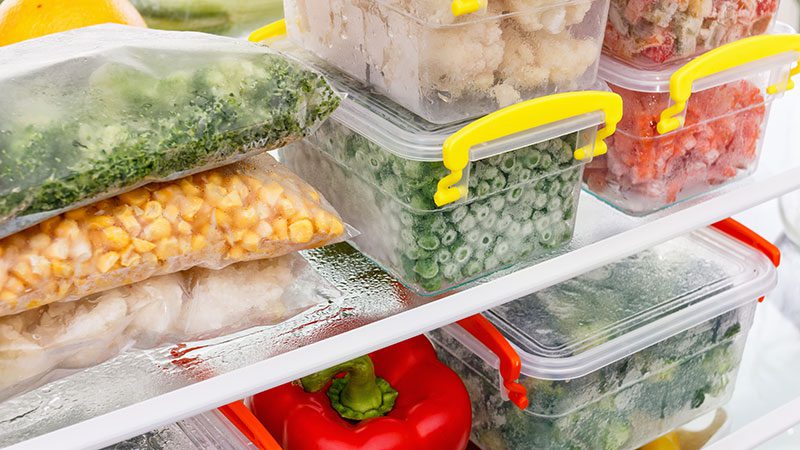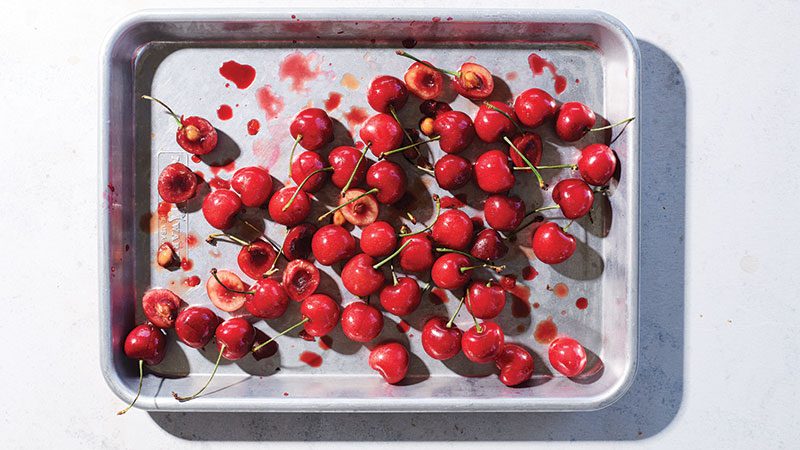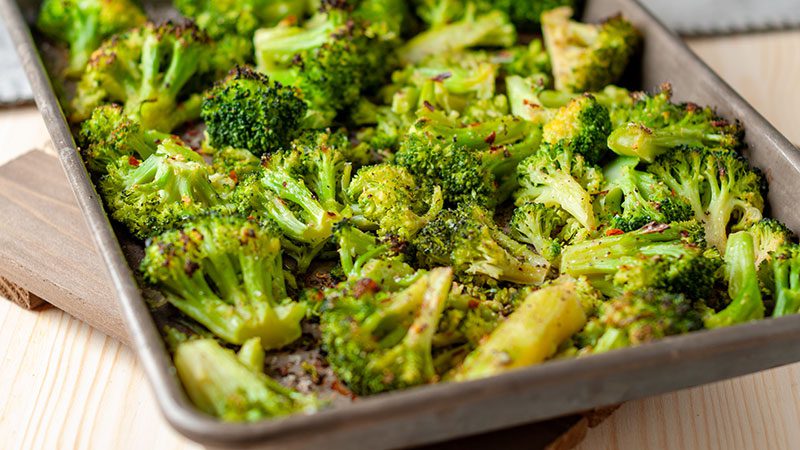What you can (and cannot) do with frozen produce
By Kim O’Donnel, guest contributor

As a kid growing up in the 1970s, vegetables at our house were rarely fresh. They came from boxes and bags and were prepared the same way — boiled into submission, with a flourish of butter sliding off the top. I remember my mother marveling at the instant-presto quality of boil-in-a-bag broccoli in cheese sauce to go alongside boneless chicken breasts or ketchup-glazed meat loaf, and why not? There was a certain kind of freedom that came from choosing side dishes from the door of the freezer rather than chopping and fumbling through a recipe.
That freedom — of convenience — is indisputable and remains so fifty years later. Frozen produce is washed, peeled, pre-cut, and ready to go whenever you are. You don’t even need to buy fresh avocados anymore. Morning smoothies are a no-brainer; from ice chest to blender, you can blitz frozen chunks of spinach and pineapple, berries and mango (or even far-flung tropical jewels like dragon fruit and acai) and be slurping breakfast in moments.
The pluses are many: Frozen produce is often more affordable; it takes up less space; and it eliminates the stress of using fresh ingredients before they become unrecognizable in the refrigerator crisper drawer.
But versatile? That depends. With convenience come caveats.
If you want to do more than whip up smoothies, or boil-and-serve like my mom did, there are ways to have a meaningful relationship with frozen produce. Through trial and error, we’ve got some tricks up our sleeve.

Baking with frozen fruit
I have pie queen and author Kate McDermott to thank for opening my eyes to baking with frozen fruit. In her book Art of the Pie, McDermott writes about picking sour cherries from a tree in her Port Angeles neighborhood, fruit that she’ll pit and freeze so she can make sour cherry pies all year long. As far as she’s concerned, use frozen fruit as you would fresh. The key: Do not thaw the fruit. Transfer directly from the freezer to a bowl for seasoning and thickening and into a dough-lined pie plate.
After learning this trick, I now keep sour cherries, blueberries, and cranberries in the freezer to use for buckle and cobbler, two colonial era-cousins of the pie. Frozen fruit also works great in muffins and quick breads; however, you may need to bake for a few minutes longer than when using room-temperature fruit. For pancake batter, I recommend thawing and draining fruit before using.
Bulk up soups and stews WITH FROZEN VEGETABLES
Frozen leafy greens like collards, kale, and spinach can be dropped directly into a pot of soup or stew from the freezer. Bring up to a boil so that greens integrate quickly and that the extra water has a chance to evaporate. I recommend tasting for salt and acid when the dish is warmed through. Other potential partners: Curries, gumbo, bean chili, and pasta sauce.
Also: Frozen corn kernels thaw almost instantly in a simmering pot, as do peas, and can hold off the Mush Monster.
Not recommended: Frozen carrots, green beans, and okra, all are too soft to swim in a big pot and will easily dissolve or turn into unpleasant mush.
Enhance pastas and frittatas with frozen produce
When you thaw frozen greens and squeeze like crazy to get rid of their water, you’ve got green matter that plays nicely in omelets and frittatas, or sautéed in oil with onions and garlic and tossed with short pasta like penne or rotini. Be sure to cook out any remaining water and taste for salt. A squeeze or two of lemon is good here, as is a sprinkle of red chile flakes. Frozen greens prepared this way are terrific as a pizza topper.

Best frozen vegetables for roasting
My editor set forth a challenge: Is it possible to mimic the nutty caramelization of roasted Brussels sprouts when using frozen? Or the frozen counterparts of any oven-friendly veg, for that matter?
I embarked on a highly unscientific kitchen experiment, testing the sear-ability and caramelization quotient of five kinds of frozen vegetables: Brussels sprouts, broccoli, cauliflower, okra, and butternut squash.
I used the same method for all:
Preheat the oven to 425 F. Place a sheet pan on the bottom shelf of the oven, where it’s hottest, and preheat for 5 minutes.
Remove the pan from the oven and scatter the vegetables onto the preheated pan; you should be able to hear the sizzle. Return to the oven without oil or salt (or any other kind of seasoning). This allows the ice crystals to evaporate without any disruptions.
Roast for 10 minutes.
Transfer vegetables to a bowl and coat with oil and salt (and any other spices). Arrange the frozen vegetables in a single layer on the sheet pan, making sure they’re not touching. Return to the oven and cook until tender and showing signs of browning or charring.
This is where timing differs, depending on the size and shape of the vegetables. The petite broccoli florets needed only 5 additional minutes, but the larger cauliflower needed up to 20 minutes to reach an appropriately roasted state.
I also tested roasted-ness using parchment paper-lined pans — and pans without the paper. The broccoli loved being smack against the metal, but the squash did not — at all.
I tasted each vegetable hot out of the oven. My rankings, in order of Yes, Please! to No, Thanks are: Broccoli, cauliflower, Brussels sprouts, butternut squash, okra.
As much as I love okra, I will never repeat this frozen experiment with them again; they turned to mush and were DOA as I removed the pan from the oven.
Although the Brussels sprouts ranked in the middle, I saw potential for further experimentation. They got good color, but next time, I need to season more assertively. Lemon, perhaps. Or a splash of Balsamic vinegar, or pomegranate molasses.
The broccoli achieved the best amount of char and nuttiness I have come to expect from a roasted vegetable. I am definitely adding this to the rotation.
DIY Projects
I’ve been preserving seasonal produce for nearly 15 years, but it took a while to appreciate how much you can “put up” in the freezer. Before I met Holly Capelle, a gardener, preserving expert, and social media influencer outside of Portland, my freezing projects were few — corn kernels, berries I picked, and roasted squash I portioned into jars for pumpkin bread. In her forthcoming book, Preserving the Seasons, Capelle devotes an entire chapter to freezing, which she describes as the “easiest, most accessible form of preserving.” (Disclosure: I worked as an editor on Capelle’s manuscript.)
“Freezing is a simple way to preserve my garden bounty and seasonal store finds,” Capelle said. “While I use a variety of home preserving methods, freezing is my go-to for produce like berries, spinach, carrots, and green beans.”
“The freezer also plays a big role in zero-waste,” she said. Capelle saves vegetable scraps throughout the week and keeps in a 1-gallon bag in the refrigerator until she has 6 to 8 cups. If she runs out of time, she’ll freeze the scraps on a sheet pan until solid. When she’s ready to make broth, she said, she thaws and drains the scraps and gets a pot of broth going.
Can you stir-fry frozen vegetables?
A quick stroll through any supermarket frozen food aisle and you’ll see bags of mixed vegetables touting their magic stir-fry-able powers. But Grace Young, the award-winning cookbook author and food historian known as “The Stir-Fry Guru,” begs to differ.
“Ninety-eight point nine percent of the time you should not stir-fry with frozen vegetables,” said Young. “The excess moisture cools down the wok and turns the stir-fry into a braise. It’s actually worse than having sopping wet [fresh] vegetables.”
The goal in stir-frying, said Young, is “to cook vegetables into a state known as crisp-tender. And given the state of frozen vegetables, there is no chance of reaching crisp-tender.”
However, there are a small number of stir-fries using frozen peas, said Young. She points to Yangchow Fried Rice, a classic soy sauce-free dish served at Chinese banquets that calls for “ham, a little bit of shrimp, chopped scallions, and frozen peas.” Frozen peas also appear in Hong Kong-Style Silky Stir-Fried Minced Beef, “the equivalent of an American meat loaf but in a stir-fry.”
“I never recommend frozen vegetables for stir-frying,” said Young, “but frozen peas, which have been used by Chinese cooks for the past 50 years, seem to complement basic stir-fries.”
Why frozen produce is different
It’s all about the water. Fresh produce is loaded with water, about 90 percent, sometimes more. That water is stored in plant cells, which give fruits and vegetables their distinctive structure and texture.
When the water in those cells freezes, it expands and turns into ice crystals. Those cells break down and are not so tough anymore. When frozen produce is allowed to thaw, it’s watery and sometimes mushy, and not as versatile as their fresh counterparts.
